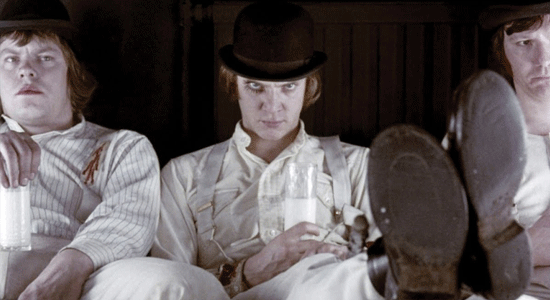MAGNET contributing writer Jud Cost is sharing some of the wealth of classic films he’s been lucky enough to see over the past 40 years. Trolling the backwaters of cinema, he has worked up a list of more than 500 titles—from the silent era through the ’00s—that you may have missed. A new selection, all currently available on DVD, appears every week.

A Clockwork Orange (1971, 137 minutes)
A single page from a vintage petition went up for auction on eBay recently, originally mailed to Stanley Kubrick before he started shooting A Clockwork Orange. It urged the director to cast Mick Jagger in the film’s lead roll as Alex, an excessively violent gang leader from the near future. Among others, the entreaty was signed by all four of the Beatles. No offense to Mr. Jagger’s flare for the dramatic, but even Jumpin’ Jack Flash couldn’t have topped the brilliant work of Malcolm McDowell in the finished product.
Some of the reviews at the time criticized Clockwork for the havoc that might be raised by copycat teenage gangs who’d seen the film. The subsequent rape of a young girl in Lancashire while the perpetrators warbled “Singing In The Rain” devastated Kubrick to the point that he pulled the film from release in England for decades.
But it was the use of Gene Kelly’s own version of the song from the film of the same name to accompany the picture’s most brutal scene, the rape and murder of an elderly couple in their own home, that raised hackles everywhere. Reportedly, Kelly himself wasn’t too thrilled with the demented use of his classic material in such a manner. No report has surfaced as yet from the camp of Ludwig Van Beethoven, whose fourth movement of his Ninth Symphony, with lyrics by poet Friedrich Schiller from his “Ode To Joy,” was employed in many of the other vicious scenes from the film.
Nor has British composer Henry Purcell checked in yet with his thoughts on the use of his stately “Funeral March For Queen Mary,” composed in 1695. The version employed here is an electronic re-imagination recorded in 1971 by Walter (now Wendy) Carlos. It rolls menacingly behind the film’s opening sequence, Alex and his three droogs lounging drunkenly outside the Korova Milk Bar, the leader decked out in a bowler hat and sporting a false ladies’ eyelash under his right eye. The latter fashion statement came courtesy of one of Kubrick’s film crew who dug deep into her purse to volunteer the essential wardrobe prop after the director said he felt the scene was still missing something.
Perhaps the picture’s most interesting element is the use of a futuristic teenage lingo by Alex and his cronies that may force readers of the film’s original source, Anthony Burgess’ book of the same name, to keep a vocabulary crib-sheet handy, like you would for the multiple characters in a Dostoyevsky novel. Most print copies of Burgess’ work come with its own mini-dictionary in the back. The language in question is a combination of Russian, Slavic and Gypsy dialects liberally sprinkled with Cockney rhyming slang in a way that gives the story an absurdly menacing (yet intriguing) flavor all its own.






